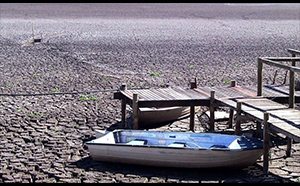Education Inequalities
A massive amount of people on this globe do not have resources that allow them access to education, and a majority of them are children in unprivileged societies.
Those living in north-eastern Africa are the least likely to receive a good education – or any education at all. It ranks the world's poorest countries according to their education systems. Somalia has the least functional system in the world with just 10% of children going to primary school, while Eritrea is second worst.
Haiti, Comoros and Ethiopia fare almost as badly. Before Haiti's earthquake this year, just 50% of children went to primary school. Now that figure is said to have fallen. Some 2.5 million children were left without a school to go to after the earthquake.
Here are 10 of the greatest challenges in global education:
A Lack of Funding for Education
Money isn’t everything, but it is a key foundation for a successful education system.
Having No Teacher, or Having an Untrained Teacher
We’re facing multiple challenges when it comes to teachers. Not only are there not enough teachers globally to achieve universal primary education (let alone secondary), but many of the teachers that are currently working are also untrained, leading to children failing to learn the basics, such as maths and language skills. Globally, the UN estimates that 69 million new teachers are required to achieve universal primary and secondary education by 2030. Meanwhile, in one out of three countries, less than three-quarters of teachers are trained to national standards.
No Classroom
This seems like a pretty obvious one – if you don’t have a classroom, you don’t really have much of a chance of getting a decent education. But again, that’s a reality for millions of children worldwide. Children in many countries in Sub-Saharan Africa are often squeezed into overcrowded classrooms, classrooms that are falling apart, or are learning outside.
A Lack of Learning Materials
Outdated and worn-out textbooks are often shared by six or more students in many parts of the world. In Tanzania, for example, only 3.5% of all grade 6 pupils had sole use of a reading textbook. In Cameroon, there are 11 primary school students for every reading textbook and 13 for every mathematics textbook in grade 2. Workbooks, exercise sheets, readers and other core materials to help students learn their lessons are in short supply. Teachers also need materials to help prepare their lessons, share with their students, and guide their lessons.
The Exclusion of Children with Disabilities
Despite the fact that education is a universal human right, being denied access to school is common for the world’s 93 million children with disabilities. In some of the world’s poorest countries, up to 95% of children with disabilities are out of school. A combination of discrimination, lack of training in inclusive teaching methods among teachers, and a straightforward lack of disabled accessible schools leave this group uniquely vulnerable to being denied their right to education.
Being the ‘Wrong’ Gender
gender is one of the biggest reasons why children are denied an education. Despite recent advances in girls’ education, a generation of young women has been left behind. Over 130 million young women around the world are not currently enrolled in school. At least one in five adolescent girls around the world is denied an education by the daily realities of poverty, conflict and discrimination.Poverty forces many families to choose which of their children to send to school. Girls often miss out due to belief that there’s less value in educating a girl than a boy. Instead, they are sent to work or made to stay at home to look after siblings and work on household chores.
Living in a Country in Conflict or at Risk of Conflict
There are many casualties of any war, and education systems are often destroyed. While this may seem obvious, the impact of conflict cannot be overstated. In 2017, around 50 million children were living in countries affected by conflicts, with 27 million of them out of school, according to UNICEF. Conflict prevents governments from functioning, teachers and students often flee their homes, and continuity of learning is greatly disrupted. In total, 75 million children have had their education disrupted by conflict or crisis, including natural disasters that destroy schools and the environment around them.
Distance from Home to School
For many children around the world, a walk to school of up to three hours in each direction is not uncommon. This is just too much for many children, particularly those children with a disability, those suffering from malnutrition or illness, or those who are required to work around the household. Imagine having to set off for school, hungry, at 5 a.m. every day, not to return until 7pm. Many children, especially girls, are also vulnerable to violence on their long and hazardous journeys to and from school.
Hunger and Poor nutrition
The impact of hunger on education systems is gravely underreported. Being severely malnourished, to the point it impacts on brain development, can be the same as losing four grades of schooling. Around 171 million children in developing countries are stunted by hunger by the time they reach age 5. Stunting can affect a child’s cognitive abilities as well as their focus and concentration in school. As a result, stunted children are 19% less likely to be able to read by age eight. Conversely, good nutrition can be crucial preparation for good learning.
The Expense of Education
In many developing countries, over the last decades governments have announced the abolition of school fees and as a result, seen impressive increases in the number of children going to school. But for many of the poorest families, school remains too expensive and children are forced to stay at home doing chores or work themselves.
Donations
You can donate money to the charities that funds education.
Fill Teacher Gaps
On current trends, some countries will not even be able to meet their primary school teacher needs by 2030. The challenge is even greater for other levels of education. Thus, countries need to activate policies that begin to address the vast shortfall.
At this primary school in the Eastern Cape, South Africa, there are 174 learners in one class. Many children don’t turn up to school because the learning conditions are so poor.
Attract the Best Candidates to Teaching
It is important for all children to have teachers with at least a good secondary-level qualification. Therefore, governments should invest in improving access to quality secondary education to enlarge the pool of good teacher candidates. Policy-makers need to focus their attention on hiring and training teachers from under-represented groups, such as ethnic minorities.
Train Teachers to Meet the Needs of All Children
All teachers need to receive training to enable them to meet the learning needs of all children. Before teachers enter the classroom, they should undergo good quality pre-service teacher education programmes and they need ongoing training so as to develop and strengthen their teaching skills and adapt to changes such as new curriculum. Teachers should be trained to teach multiple grades and ages in one classroom, in multi-lingual classrooms, and to understand how teachers’ attitudes to gender differences can affect learning outcomes.
Hadiza is a teacher in Maradi, Niger. “As soon as I got my secondary school certificate I started teaching. I was trained in 45 days and then started my career as a teacher. When I started teaching I quickly understood that the training I received was not sufficient for me to teach well. There are many challenges in teaching and I think without good capacities and some experience we are not able to handle the challenges.
Provide Better Data on Trained Teachers
Countries should invest in collecting and analysing annual data on the number of trained teachers available throughout the country, including characteristics such as gender, ethnicity and disability, at all levels of education. These data should be complemented by information on the capacity of teacher education programmes, with an assessment of the competencies teachers are expected to acquire. Internationally agreed standards need to be established for teacher education programmes so that their comparability is ensured.
More and better data on teacher salaries in low and middle income countries are also needed to enable national governments and the international community to monitor how well teachers are paid and to raise global awareness of the need to pay them well.

Smoking Tobacco & Nicotine Addiction
Nearly 6 million people die of tobacco-related diseases each year, including more than 600,000 nonsmokers who are exposed to secondhand smoke. Smoking has become an extensive epidemic.

Unemployment
Employment is central in our lives. However the issue of unemployment is a major setback to the majority of the countries.

Large Scale Conflict and Wars
38.9 percent of those polled ranked the possibility of large-scale war as the most serious global issue.

Climate Change and Destruction of Natural Resources
The Earth's climate has changed throughout history. What about now? You have the power, there are several things that you can do.

Violence Against Women & Child Abuse
Violence against women and children is a serious public health concern, with costs at multiple levels of society.

Orphans
Not everyone is called to adopt, but everyone can do something. Here are four great ways to engage your family in showing hope!

Sex/Human Trafficking
Many people would say slavery ended after the emancipation of the slaves in 1865, but human slavery still exists today in the form of human/sex trafficking.

Obesity
Overweight and obesity are defined as abnormal or excessive fat accumulation that may impair health.

Education Inequalities
A massive amount of people on this globe do not have resources that allow them access to education, and a majority of them are children in unprivileged societies.

Water Crisis
All life on Earth needs water to exist, however fresh water consumption is increasing at an unsustainable rate causing irreversible damage. The fresh water shortages occurring can become globally catastrophic.

Alcoholism
Alcoholism is the inability to control alcohol consumption due to a physical and emotional dependence. Regardless of the severe consequences that accompanies alcoholism, eliminating it is an extreme challenge.

Malnutrition & Vitamin Deficiencies
Malnutrition is estimated to contribute to more than one third of all child deaths, although it is rarely listed as the direct cause.
